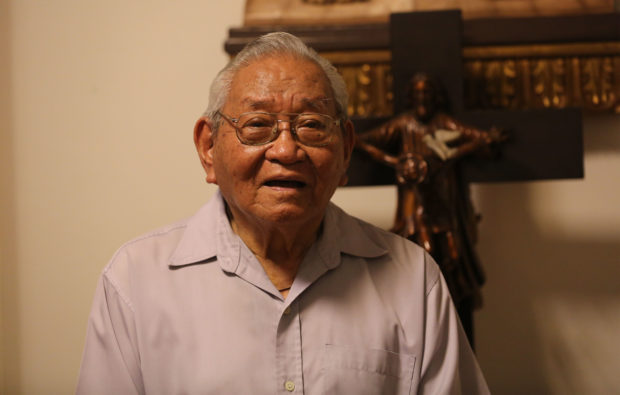Priesthood doesn’t end in retirement
(First of two parts)
What happens to priests when they grow old?
There are some who quietly fade away, and there are more fortunate ones like Msgr. Vicente Dacuycuy Jr., who happily says yes to requests for him to wear his soutane again.
At 90, Dacuycuy prefers to be active even in retirement by saying Mass or hearing confession every now and then.
Tapping his legs, the native of Pasuquin, Ilocos Norte province, concedes that age has caught up with him and that he, like the other priests at Cardinal Sin Welcome Home, is not as strong as he used to be.
“My muscles are weak, so I have to use a cane. I don’t want to use a wheelchair. I avoid sitting or lying around. I want to be on my feet,” he said.
Retirement home
Dacuycuy is one of 17 priests living in the five-story home for retired clergymen located at Our Lady of Loreto Parish compound in Sampaloc, Manila.
Although he has been retired for almost 16 years — priests are required to retire when they turn 75 — Dacuycuy says men of the cloth never really leave their vocation when they retire.
From time to time, he gets requests to say Mass, hear confession or even officiate at weddings. “When you retire, you’re still a priest. You can still give the sacraments, carry out the duties of a priest but you no longer have administrative duties,” he said.
Dacuycuy started out as an assistant parish priest at Immaculate Conception Parish in Malolos, Bulacan province, in 1958.
His last assignment was at Christ the King Parish in Las Piñas City, where he served as parish priest from 1994 until his retirement in December 2002.
Dacuycuy is one of the first residents of the retirement home built in 2002 during the term of Jaime Cardinal Sin as Archbishop of Manila.
Typical day
A typical day may begin as early as 3:30 a.m. if he has activities for the day, or at 5 a.m. if his schedule is free. His day always begins with prayers, as they have for more than 60 years.
Dacuycuy admits being bored when he doesn’t get any requests or visitors, and tries to break the monotony by visiting his former parish in Las Piñas or traveling to Manaoag in Pangasinan province. “I am provided with a driver and a vehicle so I sometimes go out, sometimes with my brother-priests,” he said.
A regular activity for Dacuycuy is his weekly 6:15 a.m. Sunday Mass at Our Lady of Loreto Parish. He says it is his way of helping the parish where he has lived since 2002.
He is thankful to the Archdiocese of Manila for taking care of him. He no longer has any surviving siblings.
Cared for
At the retirement home, the priests receive regular health checkups, a steady supply of maintenance medicines, and are provided with caregivers or nurses.
Dacuycuy says he has no illnesses, only the weakness that comes with old age. He avoids eating meat and fatty foods, preferring Ilocano dishes packed with vegetables and fish.
“Sometimes, I get lonely. But I am more concerned with my health when I walk. I can no longer go to see the places I want to see, unlike when I was younger,” he said.
Retired priests like him who served the Archdiocese of Manila, he says, are more fortunate than those in other dioceses, which do not have their own retirement homes for priests. “We are very lucky here, unlike in some dioceses that do not have enough funds for retired priests,” Dacuycuy said.
“Some priests have nowhere to go when they get old. Sometimes they don’t have any family left, no place to stay. So it’s only right that we take care of our brother-priests as they get old,” said Fr. Jose Alan Dialogo, the retirement home’s director.
Ailing residents
Dacuycuy is the retirement home’s oldest resident, while the youngest is 62 years old.
Some of the residents have heart ailments, diabetes or dementia.
Those who are unable to walk are served meals in their rooms, while those who can still move around take their meals in a common room called Father’s Room.
Not all retired priests of the Archdiocese of Manila are staying at the retirement home. Some of them, according to Dialogo, prefer to stay with their families.
Dialogo remembers searching for 85-year-old Fr. Benedicto Jayoma to bring him to the retirement home. It was only after the priest was hospitalized last year that a concerned citizen called up the archdiocese to say that Jayoma was ill.
It turned out that Jayoma had been living in Antipolo the whole time.
“I went to him, he was unconscious for sometime after he suffered a stroke. When he awoke, I asked him, ‘Do you want me to bring you to the Welcome Home?’ He nodded. So now he’s here,” Dialogo said.
Jayoma’s nurse, Greco Lizardo, says the priest is now mostly confined to his bed and has to be turned constantly to protect him from getting bedsores.
Looking forward to visitors
“I am in contact with his relatives in Bohol. They ask me how he’s doing. I think his relatives visited him once this year, [the only time] since he was transferred here,” Lizardo said.
The residents look forward to visits from religious groups, and even from strangers who simply want to be in their company. “[Visitors] make them feel that they are loved and needed by their former parishioners,” Dialogo said.
“I hope that more laypeople will visit us. I also ask the faithful to help pray for our vocation, that there will be more priests who will follow in our footsteps,” Dacuycuy added.















